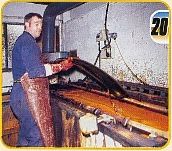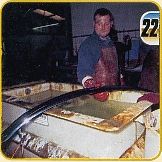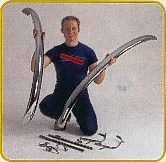



|  |
Surprisingly the bumper, which was the biggest part, only remained in here for three minutes(three minutes longer than I'd like to have been in there that's for sure!). Any longer and the metal will start to 'burn' at the edges and go grey. When they come out of here, all parts are this excellent gold colour. |  |
To remove this gold solution, all items are put through a sodium metabisulphite wash and then run through the swill tanks. After this, apart from some minor finishing by hand on the mop wheels (if needed), the parts are finished and are hung up to dry. |

|  |
Here's Alan proudly displaying the finished bumper, prior to drying and final polishing. We were lucky enough to have another NOS original German bumper to compare it with and we wouldn't be lying if we said that the newly chromed one was actually better. The original one was hung in the tank using bolts in two of the bolt holes, so has small marks around them. OK, so we're getting petty now but why shouldn't we? |  |
As part of Mike's
rigorous daily
physical training
schedule, he
swapped his free
weights for this pair
of beautifutly
chromed bumpers.
Ooh, they were
neavy... Check the finish on the two bumpers one is NOS, the other is re-chromed. We bet you can't tell which is which. |
 |
So what will all this cost you? Prices are approximate as it depends on how bad your chrome is to start with. The worse it is, the more work (read: cost) there is involved. Blade bumpers: £90 each, overiders: £12 each, hubcaps: £22 each, headlight rims: £16 each, handles: £15 each, quarterlight frames: £20 each, division bars: £9 each, small catches etc, £5 each. VAT is applicable and, unless you live nearby, postage and packing will be, too. |

| Helpfut hints: Never let road salt dry on chrome, always wash it off with water. In this country it contains sulphur, which combines with acid rain to make a weak solution of sulphuric acid precisely what the professionals use to strip chrome! In the winter, coat your chromework with a non-penetrative oil or wax. You can use WD40 but make sure it doesn't get into any cracks in the paintwork as it will lift it off. Don't use abrasive chrome cleaners - these are designed to resurrect damaged chrome. Good chrome should only be cleaned with a nonabrasive silver polish eg, Silvo. Don't bother trying to get stainless steel or aluminum parts chromed. It's possible but it isn't really worth the hassle, and the longevity of the finish can't be guaranteed. When deciding to get your chrome restored, plan well in |
advance. All good chromers will be busy. Also, don't expect to get the whole lot done in a day. Quality work takes time. When investigating a chrome platers check the following: Do they do the polishing and chroming work on site? It may be cheaper to get them done separately but if it goes wrong, they'll blame each other. Do they plate correct[y? ie, slowly and with good preparation. Do you feel confident that they'll not lose any of your stuff (this is apparently very common). Do they know what they're doing ie, have they got the correct solutions for the different metals? Do they do specialised finishes, for use on suspension components, for example? Normal chrome will just flake off when items are put under stress but we had an anti-roll bar done in dull nickel, then polished, then chrome-plated |
on top. The results don't look any different to normal chrome but, according to Alan, we could now bend the bar in two and the chrome won't crack. It is this kind of specialised knowledge of the subject that sets the professionals apart. Ask to see examples of their work, check out their tanks and see if you can watch them at work. Finally, here's some wise words from Alan Oiner, the proprietor of Marque Restore. 'You've heard of triple plating. It's b******s. There's no such thing; it's quadruple plating.' This is a term used to refer to a less-effective process which involves laying on a thick acid copper layer, before the nickel and before the chrome, thus avoiding having to prepare the base metal properly first. Thing is, you can't put acid copper straight onto steel, you have to put a flash coat of cyanide copper or nickel on first, hence the quadruple process. To finish |
it off, the items are then shined up on a mop. This heats the copper and causes it to flow across the surface and Fill any minor blemishes. This process is quicker to prepare, saves on the cost of expensive nickel and means you can get away with less skilled polishers. It produces very good results, too, which will hold their shine and last for a long time. The problems start though when the copper and steel layers react together, resulting in the steel literally being eaten away underneath the chrome layer. The only time Marque Restore would use this kind of process is if the metal to be chromed is too thin, too badly damaged or not good enough quality to be polished properly. Many thanks to: Alan, Bill, Sharon, Mick, Malcolm and Graham at Marque Restore, Unit 4, Shitton Industrial Estate, Shilton, Coventry CV7 9JY. Tel: (024) 76622225. |
| |